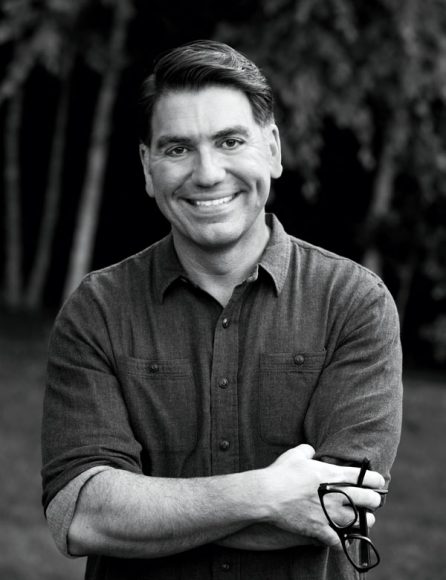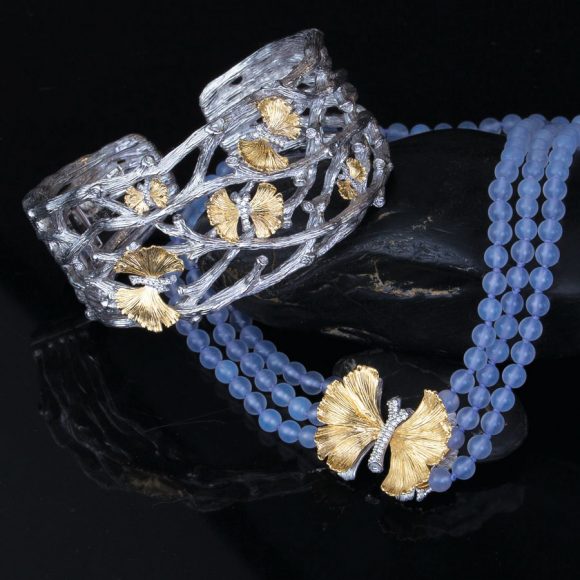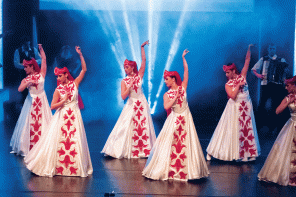Told that WAG has selected him as one of its fascinating men of 2019, artist-designer Michael Aram (pronounced a RAM) says, “I hope I don’t disappoint.”
How could he? Here is someone who has thought deeply about life from the time he was young.
“When I was a child, I would lie awake and think about our place in the world, not just as a way of understanding the cycle of life but the cyclical nature of everything,” says Aram, who grew up in the Edgemont section of Greenburgh.
That life of magical thinking has led to a career that takes an unusual view of organic forms. Considering the sunflowers that grow at his house in the Hamptons, he takes pleasure not only in the blooms at the height of their beauty but also in their underpinnings and the moments when they are spent and go to seed, what he calls the “tortured sunflowers” of Vincent van Gogh.
So, his collections, which use sterling silver, 18-karat gold and precious and semiprecious stones — feature sunflower pendants in white diamonds but also in black diamonds, while such objets d’art as picture frames and a salad serving set are braced by skeletal branches.
“Everything’s a little off,” he says, and yet it is exquisitely crafted, perfection rendered imperfectly or, more precisely, the imperfect rendered perfectly.
We are talking at Neiman Marcus Westchester in White Plains before Aram’s trunk show begins. The past truly is another country: Aram spent much of his childhood across Maple Avenue, where Saks Fifth Avenue was once located. He was the son of the store’s general manager and as such enjoyed ice cream in the Dogwood Terrace restaurant and special meets with Santa. Aram’s parents were avid gardeners, which he celebrates in his Dogwood collection for the home. When it came time for higher education, he chose Bates College in Lewiston, Maine, which maintains a 600-acre nature preserve near Campbell Island as well as a coastal center on Atkins Bay.
Aram says he knew he would spend most of his life in urban areas, so he wanted an exurban experience.
After studying art and art history at Bates, he returned to New York to work at The Metropolitan Museum of Art in Manhattan.
“Those were in the days (the mid-1980s) before computers when cut and paste was done by hand,” he recalls.
At The Met, he did layout boards and photo stylings for the museum’s sumptuous books. Everything was specialized, whereas he saw himself more as a general artist and a storyteller. His vision of a more integrated approach to work was about to get some reinforcement. In 1988, he saw the Cooper Hewitt, Smithsonian Design Museum’s show on Alexander Calder, which replicated a room in his Connecticut home in which virtually everything was designed by the artist himself. Then Aram went to visit friends in India. Wandering around historic Old Delhi in the heart of modern Delhi, Aram observed craftsmen creating beautiful objects that went beyond mere functionality. India is a country that teems with color, pattern and texture — with life itself. It’s also a country of extreme poverty. But Aram — a gentle, gracious man — says he only sees the world through rose-colored glasses.
“I saw joyfulness rather than the lack of anything. The hospitality, generosity and humanity of the people touched me.”
So much so that he created a workshop there with some 200 craftsmen that is now in Noida, a relatively new satellite city of Delhi. It’s there that Aram spends much of his time when he isn’t in New York or on the road with his works.
Back at Neiman Marcus, he poses for photographs and engraves purchases — an angel ornament from his spectacularly spectral silver Christmas tree, a pair of botanically inspired earrings and, for us, a scented candle whose silver top replicates two entwined calla lilies. Aram engraves it “With thanks, Michael.”
Among his most stunning creations, however are his sculptures inspired by the Greek myths. (These have led some people to believe he is of Greek descent, while others assume he is Jewish because of his well-known work in Judaica. Rather, he is of Armenian descent.)
The only female figure among the classically inspired works that include the winged horse Pegasus and Icarus, the youth who flew too close to the sun, is Daphne, a naiad who begged her river-god father to turn her into a tree rather than see her succumb to the advances of the sun god Apollo.
Aram captures Daphne like Icarus — with arms spread, yielding to the moment of metamorphosis. In Daphne’s case, her legs have already become the laurel tree’s trunk — “Daphne” means “laurel” — her arms have turned into leaves. It is the perfect synthesis of Aram’s thoughts on the cyclical nature of all things. And yet, he says, it is also his #MeToo moment.
No, as a fascinating man, Aram does not disappoint.
For more, visit michaelaram.com.






